This post is an explanation of what these figures are, how to read them, and why they are useful.

There are a few varieties, but they are all based on this template: a box with four positions in it, one for each limb.
It doesn’t ‘exactly’ look like a human.. but it provides a visual reference for which limbs you are to use at a certain moment. With a bit of practice this notation becomes very intuitive and easy!
HOW TO READ THIS NOTATION:
A. STANDARD coordination notation:
Hit everything inside the box at the same time.
The first notation below (grey) is the appearance used in “Complete Coordination Training”, and the black notation is used in “Layering Rhythms”.
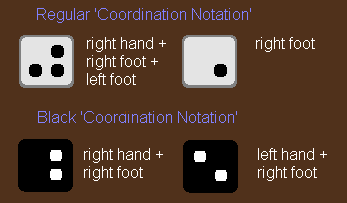
B. LINEAR coordination notation:
Play with one limb at a time in the proper sequence.
This ‘linear coordination notation’ is used in “Complete Coordination Training”.
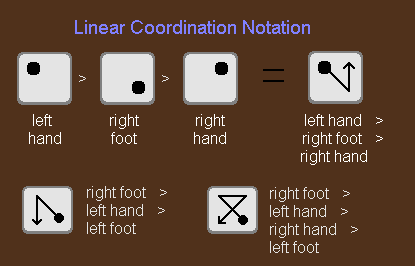
C. EXAMPLES from the books:
In the following examples, Rh = right hand, Lh = left hand, Rf = right foot, and Lf = left foot. The black / white notes are colored as such to differentiate the left and right sides of your body.. black notes are either right hand or right foot, and white notes are either left hand or left foot.
Here are a couple examples of the ‘standard’ and ‘linear’ notation, as used in “Complete Coordination Training”. Each of these examples is just one pattern, represented by standard notation on the top half and coordination notation on the bottom half.
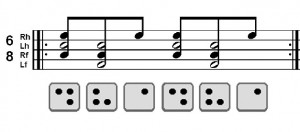
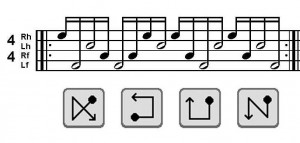
Here is an example of a single pattern from “Layering Rhythms,” represented in grid notation on top, and coordination notation below. The grid behind the notes is used to show spaces in the pattern clearly, and to make it obvious which notes line up to hit together.
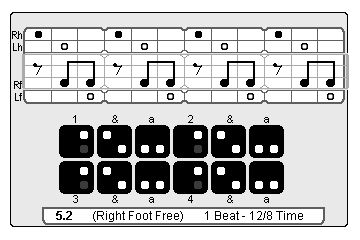
*Note: only pay attention to the WHITE dots inside the boxes; the dark grey dots are the ones filled in by the added layer.
CHARACTER LISTS:
This is the total alphabet in the language of ‘coordination notation’… there are
16 STANDARD characters,
24 LINEAR TRIPLET characters and
24 LINEAR QUADRUPLET characters.
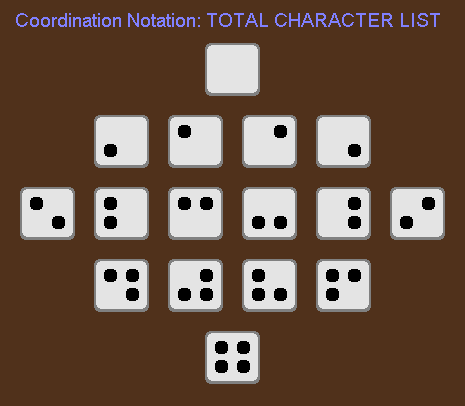
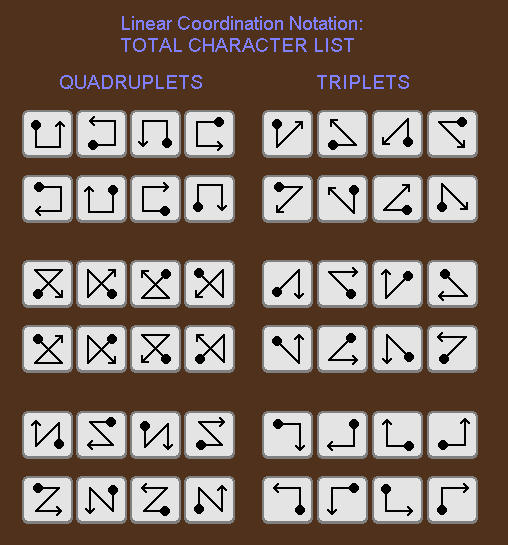
Reason For Creating This Notation
When a drummer is reading music for the drumset, it is an act of communication that tells the drummer what to do – in other words, it tells the drummer what parts of the drumset to hit, and when. If this is for musical purposes, standard drumset notation works great, but if it is for training purposes – like learning a challenging groove or developing coordination – then standard notation is only good to a certain degree.
In the learning stages of a pattern, the drummer isn’t so much concerned yet about what OBJECTS they are hitting, but rather the PHYSICAL MOVEMENTS and the RHYTHM of the pattern. Standard notation provides the necessary information, but in such a way that it may take the drummer some deciphering to figure out HOW to play each note.
Coordination Notation Works!
Thankfully, there is a better way to communicate the information needed to learn a complex pattern. Really what is crucial to know at first is which limbs strike together for each note. I tried ‘coordination notation’ on myself and a wide variety of students, and it was apparent that it worked very well and most drummers preferred it over standard notation, for challenging situations. In other words, this notation works great!
Furthermore, all drumset patterns can be simplified into this language.. it is useful to know about, so you can use it to write patterns that challenge your coordination abilities, to help you learn them.
Because both books use coordination notation, both “Complete Coordination Training” and “Layering Rhythms” have the capacity to increase your coordination abilities DRAMATICALLY when you use them as training guides!
Leave a Reply